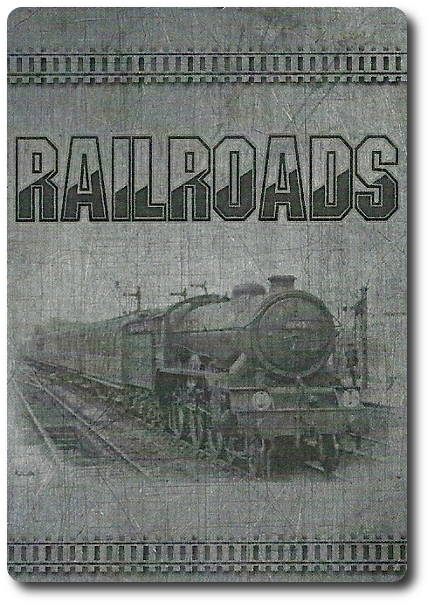
The Basics:
- For ages 6 and up (publisher suggests 8+)
- For 2 to 4 players
- Approximately 15 minutes to complete
Geek Skills:
- Counting & Math
- Logical & Critical Decision Making
- Memorization & Pattern/Color Matching
- Strategy & Tactics
- Risk vs. Reward
- Hand/Resource Management
Learning Curve:
- Child – Easy
- Adult – Easy
Theme & Narrative:
- Load and deliver goods to distant stations for fun and profit
Endorsements:
- Gamer Geek mixed!
- Parent Geek approved!
- Child Geek approved!
Overview
Supply and demand is an easy concept to grasp. If a person wants something, they are willing to pay for it. Being profitable is the real trick. To be successful, you must keep track of trends and anticipate wants and needs. If you do it right, you can make a lot of money. Do it wrong and you can lose everything. In this game, knowing your market is the key to success! All aboard the money train!
Railroads, designed by Chris Leder and published via the Gamer Crafter, is comprised of 8 Station cards, 38 Railroad cards, and 4 Reference cards. The artwork on the cards is nothing more than Photoshop images, but the icons used in the game are meaningful and kept to a minimum. The cards are made of typical cardstock used by most standard playing cards. It’s worth noting that this game was a finalist in the Micro Game Challenge hosted by the Game Crafter and sponsored by All Us Geeks and Father Geek.
Game Set Up
To set up the game, fist determine who will be the Dealer. The Dealer should give each player a Player Reference card.
Second, the Dealer separates the Station cards from the rest of the deck. The Station cards have a different card backing than the 38 Railroad cards making it an easy exercise to find and separate the two different card types. Shuffle the Station cards and place them, face-down, in the middle of the playing area. The “face” of the Railroad card is the colored side of the card.
Third, the Dealer shuffles the remaining 38 Railroad cards and deals 5 Railroad cards to each player, face-down. The Dealer gets a 6th card dealt to them. Players should look at their cards, but keep them hidden from their opponents at all times. The remaining deck of Railroad cards should be placed, face-down, next to the Station cards. This is Railroad draw deck. Draw the first card from this deck and place it, face-up, next to the draw deck. This is the first card in the discard pile.
Fourth, the Dealer either takes the top card from the draw deck or the face-up card in the discard pile.
This completes the game set up and the game now begins.
Trainspotting
There are only a few card types in Railroads. Knowing how each card type works is essential to having a profitable railroad business.
Station Cards
Station cards represent destinations the players will be sending their trains. Each Station card has two-sides. The backside of the card shows how many “Track” Railroad cards the player needs to reach it, the number of points the Station is worth, and what possible “Cargo” Railroad cards are needed. The “face” of the Station card (the side with color) has the same number of track icons and point value, but only 1 “Cargo” Railroad card icon.
Consider the following example. The Station card on the left shows the player that they need 2 “Track” Railroad cards and an unspecified type of “Cargo” Railroad card. The player knows that the Station card will award them, at the very least, 2 points. If the player can guess the right cargo that is needed, they could gain many more points than what is listed on the Station card! Once the card is flipped over (as seen on the right), the player will either make a little or a lot of points based on the cargo they sent to the station.
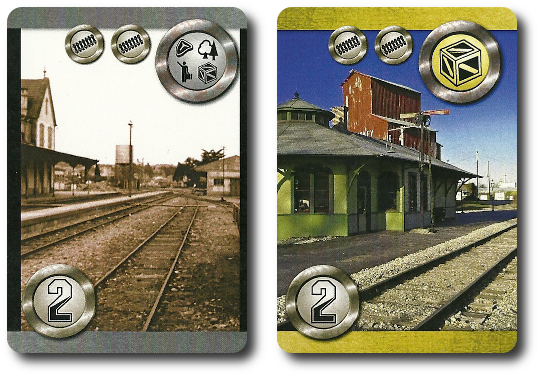
“Engine” Railroad Cards
These Railroad card types represent the powerful engines that pull and push the train.. An “Engine” Railroad card will have a number value of 1, 2, or 3. The number value indicates the amount of power the “Engine” Railroad card provides. This power level determines the total number of “Cargo” Railroad cards that can be combined with it. For example, an “Engine” Railroad card of with a power level of “2” means that a total of 2 “Cargo” Railroad cards can be coupled with the “Engine” Railroad card.
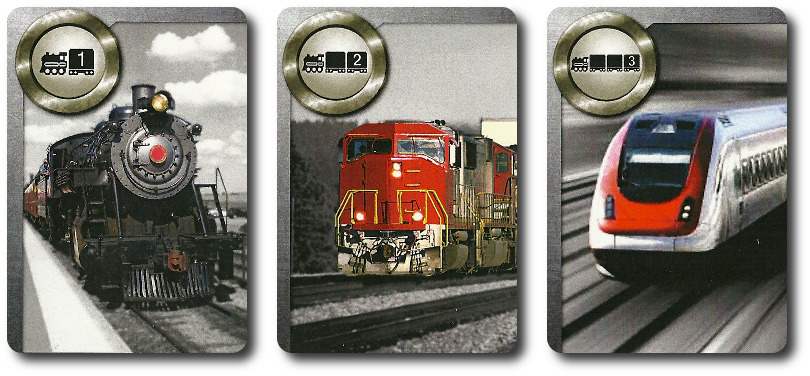
Note that “Engine” Railroad cards can be combined. For example, a player could combine an “Engine” Railroad card with a power level of “2” and “3” for a total power level of “5”! There is no limit to the number of “Engine” Railroad cards that can be combined.
“Track” Railroad Cards
These Railroad card types represent the route the player’s train will take to arrive at a station. “Track” Railroad cards will list 1, 2, or 3 track icons. Like “Engine” Railroad cards, “Track” Railroad cards can be combined to increase the overall number of tracks.
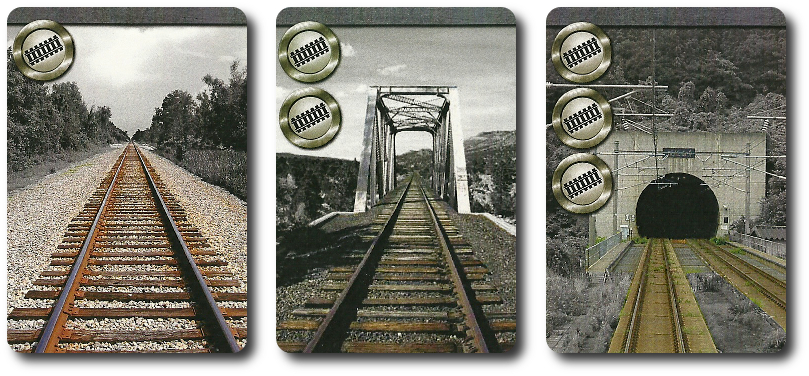
“Cargo” Railroad Cards
These Railroad card types represent the goods that are being shipped and delivered to the stations. There are 4 different types of cargo. They are “yellow” Crates, “red” Livestock, “green” Timber, and “blue” Passengers. In addition to the cargo icon, the “Cargo” Railroad card will also have a number value. This number value is used when scoring.

All Aboard!
Railroads is played in turns with no set number of turns per game. On a player’s turn, they will complete the following sequential steps.
Step 1: Draw Cards
The player’s first action is to draw up to 7 cards. Cards can be drawn from either the draw deck (which is considered a “blind draw”) or take the top most face-up card from the discard pile. Players can draw from both or only one; it’s up to them. If the Railroad draw deck is depleted, shuffle the discard pile and place it face-down to create the new draw deck. Flip the first card over and place it, face-up, next to the draw deck to create the new discard pile.
Step 2: Play a Train
This step is optional.
A “train” consists of the following cards:
- At least 1 “Engine” Railroad card
- At least 1 “Track” Railroad card
- At least 1 “Cargo” Railroad card
A player is always welcome to add more cards than the minimum required, but they cannot play any more than 6 cards in total.
When playing cards, the player needs to match the number of track icons listed on the top most Station card. Thematically speaking, the “Track” Railroad cards represents the route to the station. After that, the player needs to deliver cargo. What cargo the player selects is up to them. They can bring a mix of “Cargo” Railroad card types or only 1. Regardless of the type the player selects, they cannot bring anymore than the total power provided by their “Engine” Railroad cards.
For example, the player wants to score the top most Station card. It lists 2 track icons. The player places the following cards down in front of them.
- Two “Track” Railroad cards
- One “Engine” Railroad card with a power level of “1”
- One “Engine” Railroad card with a power level of “1”
- Two “Cargo” Railroad cards (1 Livestock, 1 Passenger)
The player then takes the top most Station card and flips it over. Any “Cargo” Railroad cards that match the cargo icon on the “face” of the Station card are scored. The played “Track” Railroad, “Engine” Railroad, and “Cargo” Railroad cards that do not match what the Station card lists are placed in the discard pile in any order the player likes. Note that the order in which the cards are placed in the discard pile is important!
The Station card and any matching “Cargo” Railroad cards are placed in a face-up pile in front of the player with the matching cargo underneath. This is the player’s Score pile. Future scored Station cards should be placed next to any existing scored stations. Scored stations are always visible to the player’s opponents.
Step 3: Pass One Card
The player now passes one card, of their choice, to the next player in turn order sequence. Note that a player must ALWAYS pass a card, which means they cannot play all 7 of their cards during step 2 of their turn!
Step 4: Discard
The last action the player takes on their turn is discarding their hand down to at least 5 cards. The player is welcome to discard all their cards, if they like, but their final hand total cannot be anymore than 5 cards in total. Keep in mind that the order in which the cards are discarded is important as the player’s opponents can draw cards from the discard pile!
This concludes the player’s turn. The next player in turn order sequence now goes.
Ending and Scoring the Game
The game ends as soon as the last Station card has been scored. All the players should now go through their Score piles and add up the number values noted on their Station and matching “Cargo” Railroad cards. The player with the most points wins the game!
To learn more about Railroads, visit the game’s web page on the Game Crafter.
Prediction
This is a very easy game to learn how to play, but it’s essential that all players understand four important points before they begin.
- Each Station card will award the player who claims it the points listed by default (regardless of what cargo is delivered)
- Each Station card only scores 1 “Cargo” Railroad type
- There are only 2 Stations for every “Cargo” Railroad type available in the game – this means that certain types of cargo will become worthless as the game progresses
- Scored “Cargo” Railroad cards are taken out of play, thus reducing the cargo of that type
Knowing this, players must watch what their opponents score. By doing so, they can begin to make educated guesses on what Station cards are still available to score for big points. If players fail to do this, they will only score the base points provided by the Station card. Since scored Station cards are always visible, players should have no problem quickly scanning the table to help them determine what the Station cards are still available.
Given the above, I predict Railroads will do very well with the Parent Geek crowd and frustrate the younger Child Geeks or any player who doesn’t take the time to keep track of what is being played. Again, a player must watch the table and keep track of what Station cards are being scored to do well. Since all players must show what Station cards they have scored, you’d think that keeping track of what is available should be an easy task, but this is not necessarily the case for the Child Geeks! You don’t need to count cards to play the game, but you most certainly need to keep track of what is being played at all times. I don’t think the Child Geeks will remember to do this throughout the entire game, resulting in poor scores.
The Gamer Geeks will most likely give Railroads a mixed endorsement at the worst. The game is not that deep, but you must be thoughtful to play it. A player needs to use strategy and tactics, too, but not very complicated ones. Essentially, there is enough of a “game” here to keep a Gamer Geek interested and engaged, but I think only the most casual of Gamer Geeks will enjoy it.
After I taught Railroads to my two oldest Child Geeks, I asked them their thoughts on the card game so far.
“Looks like an easy set collection card game. Should be fun.” ~ Liam (age 9)
“A train game with cards? That’s crazy!!!” ~ Nyhus (age 6)
Let’s get this game going and see if it’s an enjoyable journey or a very bumpy ride.
Final Word
The older Child Geeks and those Child Geeks who played a lot of card games, did very well with Railroads. It took them a few games to really get the hang of keeping track of what Station cards were scored, but they always demonstrated a clear understanding of how the cards worked together. As predicted, the game frustrated the younger Child Geeks. It was not uncommon for a Child Geek to think they knew EXACTLY what the Station card needed, only to be very disappointed when they revealed it. The first couple of times this happened to a Child Geek, everyone laughed it off. It became less funny and fun the more times it happened. Railroads is one of those games that actually becomes easier to play as the game progresses, but harder to score points as a result. This created more grimaces than smiles at times. According to one Child Geek, “I like how the game is played, but I hate not knowing if my cargo is going to be taken by the station.” Vote wise, the Child Geeks were split fairly evenly. The more mature and older Child Geeks very much enjoyed Railroads, while the younger and less experienced Child Geeks did not. However, since the younger Child Geeks were younger than the listed minimum age for the game, their vote of disapproval was not included in the final tally. This resulted in Railroads getting the Child Geek vote of approval.
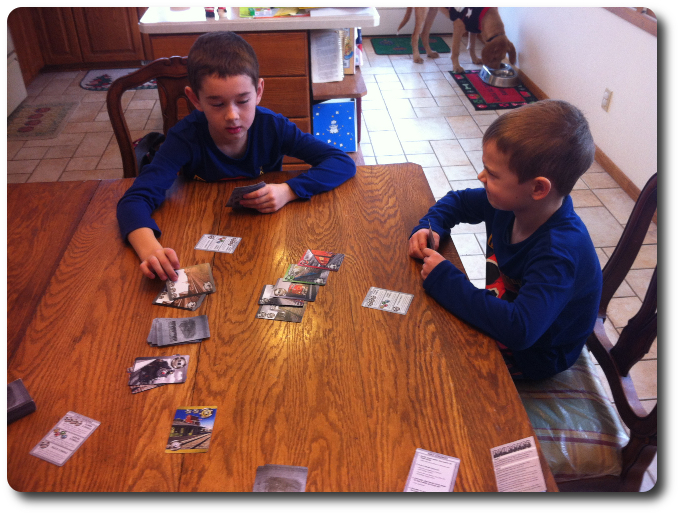
My oldest flips over the Station card as his younger brother looks on, ready to claim victory!
The Parent Geeks adored Railroads and enjoyed playing it with their family and peers in equal measure. They found the game to be casual, fun, and engaging with just the right amount of thought behind every play to keep things interesting. According to one Parent Geek, ‘This is the best train card game I have ever played.” Another Parent Geek, who loves Ticket to Ride, said “This game does a great job of capturing the fun part of train games without watering it down.” None of the Parent Geeks had anything negative to say about the game and eagerly gave it their vote of approval.
The casual Gamer Geeks enjoyed Railroads and all gave it their collective thumbs up. According to one Gamer Geek, “This is one of those card games that is deceptively simple. You really have to watch your cards to score enough points to win.” This was also a bit of a negative according to a few Gamer Geeks. One Gamer Geek who thought so said, “This game can run away from you making it impossible to catch up to a player who either guessed right or was simply lucky. I don’t like games that you can’t work hard to win if you fall behind.” A good point, but the majority of the Gamer Geeks found that the point spread was pretty even. The more hardcore Gamer Geeks voted to reject Railroads because they found it to be too basic and too much luck in the first couple of hands. According to one of the elitists, “A good card game, and one I’d play if in the right mood, but I don’t like how cornered a player gets without any opportunity to make use of meaningful tactics and strategies to get the upper hand.” In the end, the Gamer Geeks were split.
I very much enjoyed Railroads and think that Mr. Leder has done a great job of creating a fun and casual train card game. I enjoy Train games, in general, and Railroads has captured enough of what I enjoy about them to make every game playing session a very satisfying experience. Do sit down and play Railroads when the opportunity presents itself. A great game for family, friends, and aspiring railroad barons!
This game was given to Father Geek as a review copy. Father Geek was not paid, bribed, wined, dined, or threatened in vain hopes of influencing this review. Such is the statuesque and legendary integrity of Father Geek.




Railroads is a very fun and light game. I bought a copy after getting a chance to play it with Chris. Cannot have enough casual train games! hehe
Pingback: Today in Board Games Issue #113 - Today in Board Games